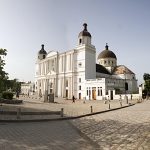Sans-Souci Palace
The Sans-Souci Palace was the royal residence of King Henri I (better known as Henri Christophe) of Haiti, Queen Marie-Louise and their two daughters. It was the most important of nine palaces built by the king, as well as fifteen châteaux, numerous forts, and sprawling summer homes on his twenty plantations. Construction of the palace started in 1810 and was completed in 1813. It is located in the town of Milot, Nord Department. Its name translated from French means "carefree."
The impressiveness of Sans-Souci was part of Henri Christophe's program to demonstrate to foreigners, particularly Europeans and Americans, the power and capability of the black race. The African pride in the construction of the king's palace was captured by the comment of his advisor, Pompée Valentin Vastey (Baron Valentin de Vastey), who said that the palace and its nearby church, "erected by descendants of Africans, show that we have not lost the architectural taste and genius of our ancestors who covered Ethiopia, Egypt, Carthage, and old Spain with their superb monuments." However, Christophe's reign drew heavily on European monarchical signs of prestige. He established a hereditary nobility, along with coats of arms and prescribed ceremonial dress.









